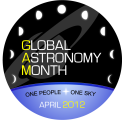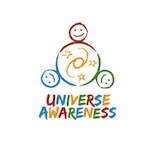GAM 2012 Blog
|
April 10 By Universe Awareness |
Back to the GAM Blog |  |
| From a very young age, children are fascinated with the beauty of the starry sky, its mysteries,and its infinite vastness, and slowly begin to form perceptions of our universe and our place in it. Many scientists also trace their passion for our cosmos to a subtle but impactful moment in their childhood. | ||
Our universe plays a special role in science because it integrates physics with mathematics, biology, and chemistry, presenting a more holistic view of our world. Recognizing this, the Universe Awareness (UNAWE) programme was established by George Miley from Leiden University, The Netherlands, with two broad visions: to use our interconnected and multicultural sky to introduce children aged 4 to 10 years to science through astronomy, inspiring them and igniting their curiosities; and to put our pale blue planet Earth in a borderless perspective and stimulate a sense of global citizenship.
Since its establishment in 2006, UNAWE has strengthened its international network to 45 countries and over 500 educators sharing the same vision. The network focuses on two main objectives: to provide training to teachers and other educators of young children, focusing on enhancing their confidence in introducing astronomy and other science topics in the classroom, and to develop educational resources that are exciting and fun, helping educators in their ambitious mission. UNAWE has been developing and collecting several useful resources such as the inflatable EarthBall, an astronomy news service for kids called Space Scoop, and newer educational materials will include illustrated hands-on games, adventure books and magazine features.

Several schools around the world have already begun to introduce astronomy at the elementary school level. But despite the enthusiasm of primary school teachers, the resources available (books, activity experiment kits, posters, computer programs, etc.) are not always suited for practical application. Practical activities are regarded as one of the necessary elements to promote understanding of scientific principles for children of all ages. A typical example is ‘the origin of seasons’. It is much easier for children to understand this phenomenon with a visual three-dimensional model rather than a two-dimensional diagram in a book or on the blackboard.
This is where Universe-in-a Box comes in: it is a low-cost educational resource designed to explain the difficult and sometimes abstract concepts of astronomy to young children by providing both practical activities as well as the materials and models required to do them.
Based on their own ‘horizon’ system (Earth), children discover the celestial phenomena in a step-by-step manner and are capable, because of their own observation, to adapt their world view to the true nature of things (e.g., the sphericity of the Earth). The activities are designed to promote not only self-discovery in children through the appropriate extension of perception and the development of spatial orientation, but also highlight the human and cultural components of life and environmental awareness. For example, one activity takes children to the other side of their home country, and they are encouraged to imagine the children on the other side: how they live, what their environment is like, and how they see the sky, thus establishing the idea that we are all inhabitants of Earth, a small blue planet.
Universe-in-a-Box helps teachers and educators overcome the hurdle of initial preparation to teach astronomical topics by choosing appropriate focus areas and materials. The activities are also designed to help make the connection between astronomy and other fields of science, art, religion, and culture and encourages hands-on learning, discussing, drawing conclusions, and presenting. The materials required for the activities are, low cost and easy to hand-make.

Universe-in-a-Box has a modular design and comes with three modules: Earth-Moon-Sun System, The Planets, and The World of Constellations. Either individual activities or entire modules can be used in the classroom, both with large and small groups. Add on modules on the life of a star, galaxies, and the Earth-Human system are currently in development, and educators are also encouraged to customize the box with additional activities and material of their own. Apart from the relevant background and activity descriptions, a handbook also offers ideas for teaching integrated astronomy with other disciplines, guidance on further experimentation, and photocopiable craft templates to extend and apply the newly learned knowledge.
UNAWE is currently working on establishing a framework for the production and distribution of Universe-in-a-Box and hopes to reach localized versions of the box to teachers, outreach centres, planetariums, and independent educators from its 45 network countries within the next three years, providing educators with a strong tool and the impetus to teach astronomy in the classroom. Universe-in-a-Box is just the start of a host of exciting resources in development by the UNAWE network and we’re happy to introduce it during the Global Astronomy Month 2012.
To know more about the project, its objectives, and the features of Universe-in-a-Box, as well as other UNAWE initiatives, please visit our website: http://unawe.org/resources/universebox/!
We are also eager to get your comments and remarks! contact us at: [email protected]
|
|
Universe Awareness is endorsed by the International Astronomical Union (IAU). It aims to use the beauty and grandeur of the Universe to encourage young children, particularly those from an underprivileged background, to have an interest in science and technology and foster their sense of global citizenship from the earliest age. Although UNAWE was only founded five years ago, it is already active in 40 countries and comprises a global network of almost 500 astronomers, teachers and other educators. The European UNAWE programme is funded by the European Community's Seventh Framework Programme (FP7/2007-2013) Credit List Concept: Cecilia Scorza (EU-UNAWE Germany/House of Astronomy)Project Management: Pedro Russo (UNAWE/Leiden University) Business Development: Jaya Ramchandani (UNAWE/Leiden University) Educational Support: Sara Khalafinejad (UNAWE/Leiden University) and Jos van den Broek (Leiden University) Authors: Pedro Russo, Natalie Fischer, and Jaya Ramchandani |








